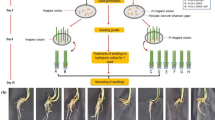Abstract
During treatment of isolated, peeled leaflets of Gleditsia triacanthos with 0.5–2 mM [45Ca]acetate, saturation of the cell-wall free space with Ca2+ occurred within 10 min and was followed by a period of 6–10 h during which there was no significant Ca-uptake into the protoplast, but apoplastic Ca2+ was periodically released into the medium. Later, Ca2+ was absorbed for 3–4 d at rates of up to 2.2 μmol Ca2+·h-1·(g FW)-1 to final concentrations of 350 μmol Ca2+· (g FW)-1. The distribution of absorbed Ca2+ between cell wall, vacuole and Ca-oxalate crystals was determined during Ca-uptake. Wheras intact, cut leaflets deposited absorbed Ca2+ as Ca-oxalate in the crystal cells, peeled leaflets lacking crystal cells accumulated at least 40–50 μmol·(g FW)-1 soluble Ca2+ before the absorbed Ca2+ was precipitated as Ca-oxalate. These observations indicate that the mechanisms for the continuous uptake of Ca2+, the synthesis of oxalate and the precipitation of Ca2+ as Ca-oxalate are operational in the crystal cells of intact leaflets, but not in the mesophyll cells of peeled leaflets where they must be induced by exposure to Ca2+. The precipitation of absorbed Ca2+ as Ca-oxalate by the crystal cells of isolated Gleditsia leaflets illustrates the role of these cells in the excretion of surplus Ca2+ which enters normal, attached leaves with the transpiration stream.
In addition to acetate, only Ca-lactate and Ca-carbonate lead to Ca-uptake, but at rates well below those observed with Ca-acetate. Other small organic anions (citrate, glycolate, glyoxalate, malate) and inorganic anions (chloride, nitrate, sulfate) did not permit Ca-uptake. Acetate-14C was rapidly absorbed during Ca-uptake, but less than 20% was incorporated into Ca-oxalate; the rest remained mostly in the soluble fraction or was metabolized to CO2. Acetate, as a permeable weak acid, may enable rapid Ca-uptake by stimulating proton extrusion at the plasmalemma and by serving as a counterion during Ca-accumulation in the vacuole, but is unlikely to function as the principal substrate for oxalate synthesis.
Similar content being viewed by others
References
Arnott, H.J., Pautard, F.G.E. (1970) Calcification in plants. In: Biological calcification. Cellular and molecular aspects, pp. 375–440, Schraer, H., ed. Appleton-Century-Crafts, New York
Borchert, R. (1984) Functional anatomy of the calcium-excreting system of Gleditsia triacanthos L. Bot. Gaz. 145, 184–195
Borchert, R. (1985) Calcium-induced pattern of calcium oxalate crystals in isolated leaflets of Gleditsia triacanthos L. and Albizia julibrissin Durazz. Planta 165, 301–310
Brummer, B., Felle, H., Parish, R.W. (1984) Evidence that acid solutions induce plant cell elongation by acidifying the cytosal and stimulating the proton pump. FEBS Lett. 174, 223–227
Demarty, M., Morvan, C., Thellier, M. (1984) Calcium and the cell-wall. Plant Cell Environ. 7, 441–448
Franceschi, V.R., Horner, H.T. (1980) Calcium oxalate in plants. Bot. Rev. 4, 361–427
Hager, A., Moser, I. (1985) Acetic acid esters and permeable weak acids induce active proton extrusion and extension growth of coleoptile segments by lowering the cytoplasmic pH. Planta 163, 391–400
Hepler, P.K., Wayne, R.O. (1985) Calcium and plant development. Annu. Rev. Plant Physiol. 36, 397–439
Jeschke, W.D. (1976) Ionic relations of leaf cells. In: Encyclopedia of plant physiology N.S., vol. 2B; Transport in plants: Tissue and organs. pp. 160–194, Lüttge, U., Pitman, M.G., eds. Springer, Berlin Heidelberg New York
Lüttge, U., Higinbotham, N. (1979) Transport in plants. Springer, Berlin Heidelberg New York
Macklon, A.E.S. (1984) Calcium fluxes in plasmalemma and tonoplast: review. Plant Cell Environ. 7, 407–414
Marmé, D., Dieter, P. (1983) Role of Ca2+ and calmodulin in plants. In: Calcium and cell function, vol. 4, pp. 263–311, Cheung, W.Y., ed. Academic Press, New York London
Marré, M.T., Romani, G., Cocucci, M., Moloney, M.M., Marré, E. (1982) Divalent cation influx, depolarization of the transmembrane electric potential and proton extrusion in maize root segments. In: Plasmalemma and tonoplast: their function in the plant cell, pp. 3–13, Marmé, D., Marré, E., Hertel, R., eds. Elsevier Biomedical Press, Amsterdam
Romani, G., Marré, M.T., Bellando, M., Alloatti, G., Marré, E. (1985) H+ extrusion and potassium uptake associated with potential hyperpolarization in maize and wheat root segments treated with permeant weak acids. Plant Physiol. 79, 734–739
Satter, R.L., Galston, A.W. (1981) Mechanism of control of leaf movements. Annu. Rev. Plant Physiol. 32, 83–110
Sze, H. (1985) H+-translocating ATPases: advances using membrane vesicles. Annu. Rev. Plant Physiol. 36, 175–208
Author information
Authors and Affiliations
Rights and permissions
About this article
Cite this article
Borchert, R. Calcium acetate induces calcium uptake and formation of calcium-oxalate crystals in isolated leaflets of Gleditsia triacanthos L.. Planta 168, 571–578 (1986). https://doi.org/10.1007/BF00392278
Received:
Accepted:
Issue Date:
DOI: https://doi.org/10.1007/BF00392278




